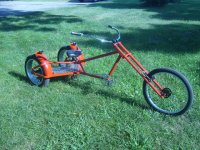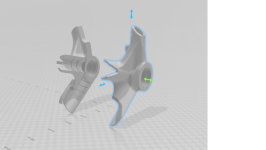RebelPrinter
100 µW
- Joined
- Aug 6, 2022
- Messages
- 8
Hey guys. I am barely (almost) finished my iZip restoration (couple of small pieces to print to mount the charging port and master switch ect, and paint the artillery shell glove box) and am already scheming my next project since I have a 36v/350w Bafang hub motor sitting here.
I would like to do a stretch low-rider trike (something along the lines of Atomic Zombies design, see the pic) but rather than weld, 3-d print (carbon-fiber PETG or maybe nylon) connectors and use 3/4" and 1" EMP as the frame rails. The drop-outs, head-tube, bottom bracket ect would be salvaged out of "junk" bikes and I can design brackets around them. The brackets would be split and assembly would be with B7000 (or epoxy) plus thru-bolted. Going with a design something like the picture below lets me use 2 regular 16" kids bikes back 1/2 for the trike assembly with independant rear wheels (no need for a diff or anything)
I'm thinking of designing the brackets so they fit both inside and around the tubes where aplicable for butt joints with about a 1" solid plastic "buffer" between the tubes and at least 12mm sleeve outside the tube, Any change in diameter bewtween the salvaged pieces and the EMT would be accomodated internally in the printed brackets. I'm printing on 220x220 bed so can get pretty decent sized gussets built into the brackets.
Can anybody poke any holes in the idea (so far ?)
I would like to do a stretch low-rider trike (something along the lines of Atomic Zombies design, see the pic) but rather than weld, 3-d print (carbon-fiber PETG or maybe nylon) connectors and use 3/4" and 1" EMP as the frame rails. The drop-outs, head-tube, bottom bracket ect would be salvaged out of "junk" bikes and I can design brackets around them. The brackets would be split and assembly would be with B7000 (or epoxy) plus thru-bolted. Going with a design something like the picture below lets me use 2 regular 16" kids bikes back 1/2 for the trike assembly with independant rear wheels (no need for a diff or anything)
I'm thinking of designing the brackets so they fit both inside and around the tubes where aplicable for butt joints with about a 1" solid plastic "buffer" between the tubes and at least 12mm sleeve outside the tube, Any change in diameter bewtween the salvaged pieces and the EMT would be accomodated internally in the printed brackets. I'm printing on 220x220 bed so can get pretty decent sized gussets built into the brackets.
Can anybody poke any holes in the idea (so far ?)



